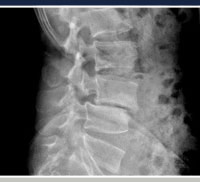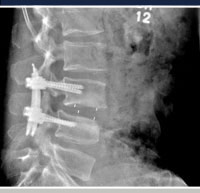Minimally Invasive Spine Surgery in Boston
 Advances in diagnostic imaging and surgical techniques, instrumentation and equipment have allowed surgeons to address certain conditions of the spine through smaller incisions and with less traumatic approaches than those associated with traditional spinal surgical techniques. The potential benefits of these new “minimally invasive” or “minimal access” techniques include:
Advances in diagnostic imaging and surgical techniques, instrumentation and equipment have allowed surgeons to address certain conditions of the spine through smaller incisions and with less traumatic approaches than those associated with traditional spinal surgical techniques. The potential benefits of these new “minimally invasive” or “minimal access” techniques include:
- smaller surgical incisions
- less soft tissue disruption and damage to spinal muscles
- less blood loss
- reduced risk of infection
- reduced scarring
- a reduction in post-operative pain
- a shortened hospital stay
- a faster recovery

Orthopaedic Spine Conditions Treated
Minimally invasive techniques may be used to address many pathologic conditions of the spine, including those secondary to degenerative problems, deformity, tumors, infection and trauma. In general, pathologic conditions of the spine can be addressed through anterior, posterior or combined (anterior and posterior) surgical approaches. Advances in minimally invasive surgery have led to improvements with the utilization of each of these approaches. For example, anterior approaches in general can be less invasive with respect to the spine itself as the spinal nerves are not manipulated and the important muscles of the posterior spine are not disturbed. Advances in spinal instrumentation, retractor systems, video technology and instruments have led to further advances in anterior spinal surgery by allowing the utilization of “mini-open” approaches or laparoscopic techniques in certain conditions, combining anterior approaches with minimally invasive posterior instrumentation may allow the benefit of addressing the anterior pathologic condition via the most direct approach, while maximizing spinal stability through the utilization of spinal instrumentation that does not significantly disrupt then posterior spinal musculature. Also, with the appropriate diagnosis and indication, minimally invasive posterior approaches may allow for both anterior and posterior spinal pathology and spinal stability to be addressed through multiple, small, posterior incisions, utilizing special retractor systems and intra-operative fluoroscopic imaging.
Although not all conditions of the spine should or can be addressed by minimally invasive approaches, with the proper indications and applications, these advances may prove to be of great benefit to patients. Combining these techniques with the utilization of biological bone growth enhancers and advanced intra-operative computerized imaging technologies may continue to improve the efficacy, safety and outcomes associated with these advances.



